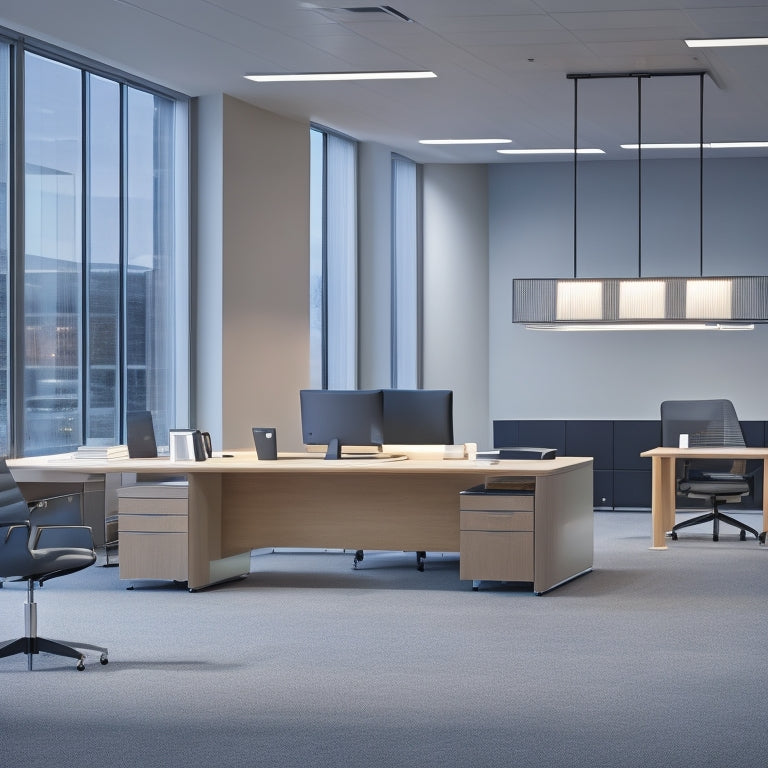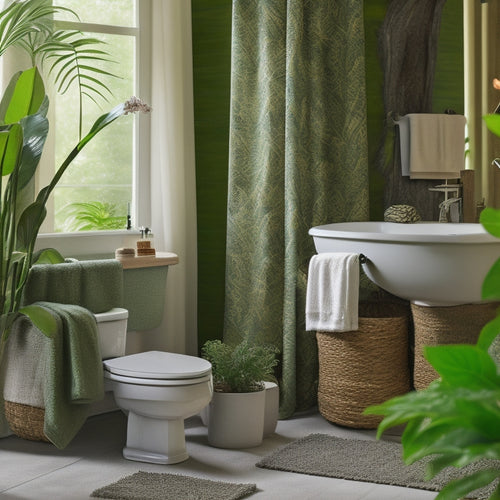
Energy-Saving Office Illumination: Smart Sustainable Lighting Solutions
Share
You're upgrading your office space to optimize energy efficiency and reduce your carbon footprint, and smart sustainable lighting solutions are at the forefront of your strategy. Consider LED lighting for commercial spaces, which can reduce energy consumption by up to 75% and enhance employee productivity and morale. Integrate smart lighting control systems, occupancy sensors, and motion-detected dimming for automated energy savings and data-driven revelations. Energy-harvesting window solutions, biophilic design elements, and retrofitting existing lighting fixtures are also innovative ways to create a sustainable, high-performance workspace. Investigate these state-of-the-art solutions to shape the future of your office illumination.
Key Takeaways
- Implementing LED lighting solutions can reduce energy consumption by up to 75% and enhance employee productivity and morale.
- Smart lighting control systems with occupancy sensors and programmable schedules can optimize energy savings and provide data analytics.
- Energy-harvesting window solutions and solar-powered windows can generate renewable energy and reduce reliance on artificial lighting.
- Retrofitting existing lighting fixtures with cost-effective solutions can minimize upfront investment and extend fixture lifespan.
- Biophilic design elements, such as natural materials and daylighting, can improve employee well-being and productivity while supporting sustainability.
LED Lighting for Commercial Spaces
Typically, commercial spaces prioritize functionality over aesthetics, but LED lighting can bridge this gap by offering a trifecta of benefits: energy efficiency, cost savings, and enhanced ambiance.
By integrating LED lighting into your office design, you can reduce energy consumption by up to 75%, resulting in significant cost savings over time. Furthermore, LED lighting's unique ability to be dimmed and color-tuned allows for customized lighting aesthetics that enhance employee productivity and morale.
With the rise of sustainable energy solutions, companies are also exploring ways to reduce their carbon footprint through energy-efficient lighting. In addition, the integration of energy storage systems can further optimize energy efficiency and reduce reliance on traditional power sources.
With LED lighting, you can create a space that's not only energy-efficient but also visually stunning, providing your team with the freedom to thrive in a well-lit, inspiring environment.
Energy-Harvesting Window Solutions
You're likely familiar with traditional windows that merely let in natural light, but what if you could utilize that energy to power your office?
Energy-harvesting window solutions, such as solar powered windows and energy generating glass, can convert your office's façade into a source of renewable energy.
By integrating these innovative technologies, you can reduce your reliance on artificial lighting and cut energy costs.
Additionally, this approach can attract eco-conscious clients and customers, increasing foot traffic and business opportunities, similar to commercial EV charging stations, and contribute to a sustainable future.
Solar Powered Windows
As you consider integrating energy-harvesting solutions into your office illumination, solar powered windows emerge as a groundbreaking innovation that can greatly reduce your reliance on artificial lighting.
By incorporating solar window technology, you can utilize the power of natural light while generating electricity. This advanced solution allows you to tap into the solar energy benefits, reducing your carbon footprint and energy costs.
By achieving energy independence and minimizing reliance on the grid grid resilience, you can enjoy a more sustainable and self-sufficient office environment, freeing you from the constraints of traditional energy sources.
With solar powered windows, you can enjoy a more sustainable and self-sufficient office environment, freeing you from the constraints of traditional energy sources.
Energy Generating Glass
Building on the concept of utilizing natural light, Energy Generating Glass takes solar window technology to the next level by integrating photovoltaic cells directly into the glass itself.
This innovative solution allows you to capture energy while maintaining transparency, thanks to its translucent technology. You can now generate electricity while still benefiting from natural light, reducing your reliance on artificial lighting and the associated energy costs.
By mitigating peak shaving and reducing grid strain, Energy Generating Glass can also contribute to a sustainable future through renewable energy use.
With Energy Generating Glass, you can seamlessly integrate energy harvesting into your building's design, achieving a higher level of building integration and sustainability.
This state-of-the-art technology offers a new degree of freedom in designing energy-efficient buildings that not only reduce their carbon footprint but also produce their own energy.
Smart Lighting Control Systems
Switching to smart lighting control systems can considerably cut energy costs and enhance office productivity. By integrating these systems, you can access a range of benefits that change your workspace. For instance, you can utilize wireless connectivity to remotely manage your lighting, while data analytics provides useful observations into energy consumption.
| Feature | Benefit |
|---|---|
| User Interfaces | Intuitive control and customization |
| Integration Systems | Seamless connectivity with other devices |
| Remote Management | Real-time monitoring and adjustments |
| Programmable Schedules | Automated energy savings and convenience |
With smart sensors and adaptive lighting, you can create an evolving environment that responds to your needs. Plus, cloud-based solutions guarantee that your system is always up-to-date and optimized for maximum energy efficiency. By making the switch, you'll be well on your way to creating a sustainable, high-performance workspace that supports your business goals.
Occupancy Sensors for Efficiency
You can optimize your office's energy efficiency by implementing occupancy sensors that enable auto-on lighting control, which automatically turns lights on when you enter a room or space.
Additionally, incorporating sustainable charging solutions can further reduce energy waste and carbon emissions.
These sensors can also be programmed for motion-detected dimming, adjusting light levels based on your movement and presence.
Auto-On Lighting Control
Nearly 90% of commercial buildings still rely on manual lighting controls, resulting in unnecessary energy waste and increased electricity bills.
By implementing auto-on lighting control, you can eliminate this inefficiency. This smart solution uses occupancy sensors to detect when you enter or leave a room, automatically turning lights on or off accordingly.
You'll enjoy the freedom to customize your lighting experience with versatile lighting options that adapt to your needs. With user customization, you can tailor the lighting to your tasks, preferences, and schedule.
This innovative approach not only saves energy but also enhances your overall workspace experience. By automating lighting controls, you'll reduce waste, lower your electricity bills, and create a more sustainable office environment.
Motion-Detected Dimming
As you maneuver through your office space, occupancy sensors seamlessly integrate with motion-detected dimming to optimize energy efficiency.
These sensors detect your presence, automatically adjusting lighting levels to suit your needs. When you leave, the lights dim or turn off, minimizing energy waste.
With daylight integration, the system adjusts brightness based on available natural light, ensuring you receive the right amount of illumination.
Adaptive brightness control further refines this process, fine-tuning lighting levels to your specific tasks and preferences.
By combining these technologies, you can enjoy a comfortable, productive work environment while reducing your carbon footprint.
With motion-detected dimming, you're free to focus on your work, knowing your lighting system is working efficiently behind the scenes.
Biophilic Design for Wellness
Frequently, offices with biophilic design elements report improved employee well-being and productivity. By incorporating nature integration into your workplace aesthetics, you can create a more inviting and calming environment. This design approach focuses on bringing the outdoors in, using natural materials, and maximizing natural light exposure.
| Design Element | Benefits | Examples |
|---|---|---|
| Living Walls | Improved air quality, reduced stress | Vertical gardens, green screens |
| Natural Materials | Warmth, comfort, connection to nature | Wooden furniture, stone flooring |
| Daylighting | Enhanced mood, increased energy | Skylights, clerestory windows |
| Biophilic Art | Calming atmosphere, reduced anxiety | Nature-inspired prints, botanical displays |
| Plants | Purified air, improved focus | Desk plants, hanging greenery |
Retrofitting Existing Lighting Fixtures
Your office's existing lighting fixtures can be a significant obstacle to achieving energy-efficient illumination. However, retrofitting them can be a cost-effective and environmentally friendly solution.
By retrofitting, you can reap retrofit benefits like reduced energy consumption and lower maintenance costs. Ascertain fixture compatibility by selecting retrofits that match your existing fixtures' design aesthetics.
Conduct a thorough cost analysis to determine the return on investment for your retrofit project. Be prepared to overcome installation challenges, such as accessing hard-to-reach fixtures or upgrading wiring.
With a successful retrofit, you can enjoy significant energy savings, reduced environmental impact, and a more sustainable office space that aligns with your values of freedom and innovation.
Frequently Asked Questions
Can Energy-Efficient Lighting Improve Employee Productivity and Focus?
You might think it's a stretch, but trust us, energy-efficient lighting can enhance your productivity and focus. By mimicking natural light with customized color temperatures, you'll stay energized and engaged, tackling tasks with renewed clarity and precision.
Are Smart Lighting Systems Compatible With Existing Building Infrastructure?
When considering smart lighting upgrades, you'll find that many systems integrate seamlessly with existing infrastructure, offering retrofit options that minimize disruptions and maximize returns, allowing you to future-proof your space without tearing it apart.
Do Energy-Harvesting Windows Generate Enough Power for Lighting?
As you gaze out the window, envision utilizing sunlight's power; with energy-capturing windows, you're generating electricity, but can it illuminate your space? Advanced window efficiency and energy-capturing technology make it possible, but you'll still need supplemental power for sufficient lighting.
Can Occupancy Sensors Detect Pets or Other Non-Human Occupants?
You're wondering if occupancy sensors can detect pets or other non-human occupants. The answer lies in advanced occupancy sensor technology, which often struggles to distinguish between humans and pets, but some innovative systems boast improved pet detection capabilities, ensuring accurate automation.
Are Energy-Saving Lighting Solutions Eligible for Government Incentives?
You'll be thrilled to know that, yes, many energy-saving lighting solutions qualify for government incentives, such as rebates and tax credits, which can greatly offset their costs, giving you the freedom to invest in a sustainable future.
Related Posts
-

Sustainable Scrubbing: Top Bathroom Solutions for Earth-Conscious Homes
You're taking an important step towards creating a more sustainable home by switching to eco-friendly bathroom cleani...
-

3 Best Solar-Powered Biodegradable Accessories for Your Home
You're taking a significant step towards a more sustainable lifestyle by incorporating solar-powered biodegradable ac...
-

10 Eco-Friendly Air Management Tools for Clean Home Living
You're taking an essential step towards creating a healthier living space by seeking eco-friendly air management tool...


